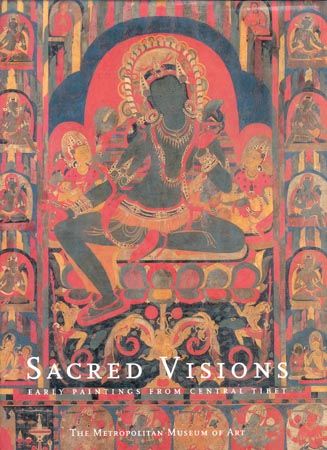|
 Sacred
Visions: Early Paintings from Central Tibet is the
catalogue of a landmark exhibition of more than sixty of the finest extant Tibetan works from museums and
private collections around the world. Closed to the West until the early twentieth century, Tibet was
abruptly closed again in the 1950s by the Chinese. In spite of the loss of much of the staggering wealth of
Tibetan monasteries and other monuments since that time, a number of masterpieces have survived in
Western collections. Sacred
Visions: Early Paintings from Central Tibet is the
catalogue of a landmark exhibition of more than sixty of the finest extant Tibetan works from museums and
private collections around the world. Closed to the West until the early twentieth century, Tibet was
abruptly closed again in the 1950s by the Chinese. In spite of the loss of much of the staggering wealth of
Tibetan monasteries and other monuments since that time, a number of masterpieces have survived in
Western collections.
Brought together for the first time, many of the
paintings have also never been published. In the catalogue, Steven M. Kossak and
Jane Casey Singer discuss the individual works in regard to their style,
iconography, provenance, and date. They explore and contextualize the painting of the eleventh to the
fifteenth century, a formative period when Tibet enjoyed extraordinary cultural achievements. During
this era, known as the Chidar, or "the later diffusion of the faith," Indian Buddhism became
firmly established in Tibet. Thousands of Indian Buddhist texts were translated into Tibetan, hundreds of Buddhist
monuments were built to adorn Tibet's vast landscape, and countless young men and women entered the
ranks of burgeoning monastic orders. Initially, some of the finest extant paintings seem to have been
commissioned from India by monasteries. These works were then used as models by Tibetan artists to create
their own thankas, paintings on cloth. Beginning in the thirteenth century, Nepalese craftsmen began to be
employed and Nepalese style paintings became the dominant mode in the fourteenth and the early fifteenth
century. It was not until the fifteenth century that Tibetans began to synthesize a truly indigenous mode
of expression from these sources as well as from Chinese influences.
In the essays, Mr. Kossak analyzes the development of style and the chronology of the works;
Ms. Singer explores the profound cultural ties between Tibet and eastern India, and, more briefly, between
Tibet and Nepal. Robert Bruce-Gardner discusses the painting techniques of the period.
STEVEN M.
KOSSAK is
Associate Curator in the Department of Asian Art at The Metropolitan
Museum of Art. He is the author of Indian Court Painting: 16th-19th Century
(1997) and co-author
(with Martin Lerner) of The Lotus Transcendent Indian and Southeastern Asian
Art from the
Samuel Eilenberg Collection (1991).
JANE
CASEY
SINGER is an art historian specializing in Tibetan art. She is co-editor (with
Philip Denwood) of Tibetan Art: Towards a Definition of Style (1997).
ROBERT
BRUCE-GARDNER is Director, Department of Conservation and Technology, the Courtauld
Institute, London.
240 pages, 149 illustrations, including 134 in full color; map; glossary; bibliography; index
click below to order
the catalogue from Amazon:
amazon.com
|